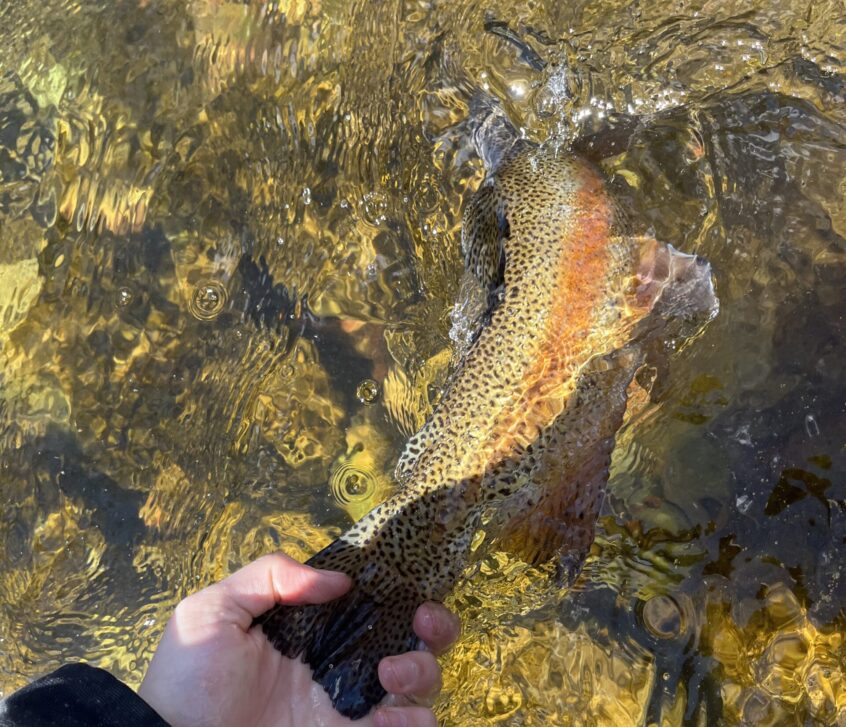Flows and Water Clarity
The Roaring Fork is running low and clear. Flows are approximately 75 cfs below Maroon Creek (gauge is ice affected) and 178 cfs at Emma. Water temperature is in the low forties.
Overview
Happy Easter Weekend! The next few days should be beautiful, so get out on the river and have yourself an Easter Trout Hunt! With forecasts in the high 40’s and low 50’s for this weekend and high temps in the 60’s early next week, midge and BWO hatches should gain some serious momentum!
As we mentioned last week, we’re starting to see the dry fly fishing pick up on the upper fork. Midges are starting to come off mid morning and BWO’s are hatching in good numbers during the middle of the day– particularly on warm, sunny days. We definitely recommend bringing your favorite lightweight dry fly set up with you when you hit the river. Fishing small midge and BWO (baetis) dries can be challenging, so make sure you’re using longer leaders, 5 or 6x tippet and making gentle presentations.
If you’re not finding success with dry flies, nymphing continues to be very productive throughout the day. During hatches, make sure you’re incorporating midge and baetis emergers into your rigs. Stoneflies continue to be a great choice for lead flies, but we are starting to see some success on caddis larva and pupa patterns (despite not seeing too many caddis around).
We continue to be on the lookout for spawning activity, if you see anything please, let us know as we want to make sure we’re helping local anglers stay off of redds. Read more below.
PSA The Rainbow Trout Spawn
Spring isn’t in full swing yet, but it’s time to start thinking about the Rainbow Trout Spawn. We know that for the most part the fly fishing community is educated and thoughtful about responsible use of the resource and protecting future generations of fish, but we think that it is still worth reminding everyone to be mindful of spawning fish as we move into spring.
Trout create spawning beds or “Redds,” which are generally found in shallow, moving water. Identifying these redds is an important skill as an angler and helps us fish ethically. Redds are generally composed of smaller rocks and gravel that are lighter in color than the rest of the river bottom due to spawning fish brushing the rocks as they mate and clearing them of algae and other organic material. These beds provide safety for the eggs and alveins (fry) that are a result of the spawn and the next generation of fish!
Stay away from redds, fish deeper water where trout are actively feeding, and use good fish handling practices. If you are hitting the water with someone who is new to the sport, please use this time of year as an opportunity to share how to fish ethically and be a steward of the resource. To learn more about fishing during the spring spawn, click here and share!
Common Hatches and Food Sources
Midges, Baetis, and Stoneflies.
Midge Larvae and Baetis nymphs are the standard sources of food present in the upper fork during the winter and late spring, but as the weather warms we are seeing larger patterns produce well. Try the Element Flies Pat’s Stone Runt (size 16, black) or a Two Bit Hooker (size 16, black).
We’re still seeing some fish rise intermittently to eat hatching midges, so make sure you have some size 18-22 midge imitations in your box!
We haven’t really been seeing them yet, but the caddis should start moving around soon. We’re having some success on generalist patterns (like size 16 Hare’s Ear) that imitate caddis well, so fish might be starting to key in on caddis larva.
Hot flies & Techniques
Nymphs
Midges and Baetis
Hot Flies: Foamback RS2 (gray, size 20), Chocolate Thunder (black, size 22), Mayhem Midge (black, size 22)
Zebra Midge (black, gray, size 18-22), WD40 (black, gray, size 18-22), Miracle Midge (gray, brown, size 18-22) RS2’s (cdc, crystal wing, black, gray, size 18-22), crystal midge (gray, olive, size 20-22), Juju Baetis (red, olive, black size 18-22), Pheasant Tail (natural 18-20).
Point Flies
Hot Flies: Two bit Hooker (black, size 16-18), Pat’s Stone Runt (black, size 16), Guide’s Choice Hare’s ear (size 16), CDC Copper John (red size 18), Perdigon (pearl, size 16), 20 incher (size 14, natural).
Tungsten jigs with hot collars (yellow, brown, pink, size 14-18), Bead Head Rainbow Warrior (classic, purple, red, size 16-20), Eggs (chartreuse, peach, white). Perdigons (olive, black, 16-18).
Dries:
Hot Flies: Griffith’s gnat (classic or hi-vis, 18-22)
Element Hi-Vis Midge (black, size 20) Parachute Adams (18-20), BWO Hackle Stacker (18-20)
Streamers:
Motor Oil (black, size 6), Slumpbuster (natural, size 8-12), Thin Mint (size 6-10).
We haven’t been throwing streamers much yet, but it might be worth a shot! This is traditionally a great time to start messing around with your streamer set up. If you whack some fish on streamers, let us know! (or don’t… we understand)
Techniques
Nymphing is the most productive technique during this time of year. Finding deep holding water and using weight to get your flies down will be crucial to success. Longer leaders and heavy split shot will help you get your flies in front of more fish. Leading with larger jig style or tungsten patterns has been a very productive technique for helping smaller flies get down deeper.
Small midges and baetis are the staples when fishing this time of year, but don’t be afraid to try something out of the ordinary. Small stoneflies are working surprisingly well right now! If you’re not finding success, get creative with your point flies– larger bugs have been producing occasionally too!
Dry fly hatches are beginning to increase in frequency, so keep an eye out for pods of rising fish. Spring dry fly hatches can be sporadic compared to the summer months, but are incredibly fun and rewarding to fish. Midges are the predominant hatch right now, so switching to small dry flies and fine tippet is your best chance at fooling fish.
As we move into spring, streamers will become important in your rotation! Small streamers tend to be best during early spring, and be sure to focus your efforts on deep pools and structure.
Information About The Roaring Fork
The Roaring Fork River is a freestone river that runs 70 miles from Independence Pass through Aspen, Basalt, and Carbondale until it reaches its confluence with the Colorado River in Glenwood Springs. The cold, clean waters of this famous river support an incredible array of aquatic life including brown, rainbow and cutthroat trout. The Roaring Fork is designated as a “Gold Medal” fishery, meaning it offers some of the best trout fishing in the nation to beginners and seasoned anglers alike.

